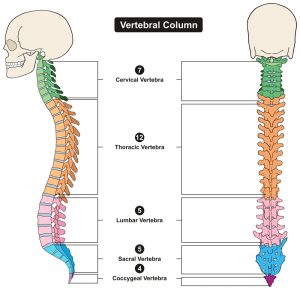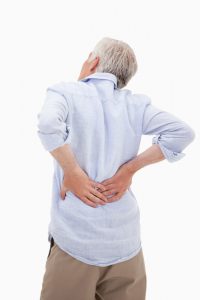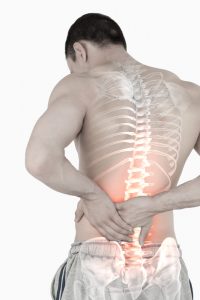What is a back hernia?

The spinal column consists of 33 vertebrae. An intervertebral disc interconnects each vertebrae. These “shock absorbers” have a firm wall of connective tissue and a core of soft jelly. Consequently, in many people, there are weak spots on the intervertebral discs. The core can then leak out, creating a bump. In almost 90 percent of cases, the hernia occurs at the three lower intervertebral discs. This is where many nerve roots are present going to the legs. If a hernia presses on such a nerve root, the nerve sends an incorrect signal to the brain. The brain translates this signal as “pain in the back that radiates to the leg”.
What are the causes of a back hernia?
While multiple issues may cause a bulge on intervertebral discs, we will cover just a few here. First of all, in more than half of the people over 50 years of age, there is wear and tear (osteoarthritis) of the back. This is due to a natural process related to ageing. Usually, this form of hernia is not directly associated with complaints. If the hernia is already occurring between 25 and 50 years, then cause can then be a heavy load on the back. Furthermore, lack of movement, prolonged sitting, weakness of the back muscles, obesity, and bad posture can consequently lead to a hernia. Hernias also occur more frequently in smokers than in non-smokers.
What are the symptoms of a back hernia?
If the bulge presses on a nerve root, the pain may be extreme. There is usually pain in the lower back that radiates through the buttock to one leg. Sometimes the pain goes on to the foot. There may be loss of power and a numb feeling in the leg. In severe nerve issues, a hernia can lead to urinating problems, paralysis, and sensation disorders. Coughing, sneezing, and squeezing increase the pressure on the spinal column, as a result this may increase the pain. If an acute hernia is not treated, it can turn into a chronic condition.
 How do you diagnose a back hernia?
How do you diagnose a back hernia?
The doctor will have to establish that a bulge of one of the intervertebral discs is the cause of the pain in the lower back and leg. He will ask for the complaints extensively and then conduct a physical and diagnostic examination. The doctor will see if he can feel the hernia. The doctor will do this by rubbing and squeezing over the painful site. In many cases, the site of the hernia is slightly swollen. In addition, he will examine which movements cause pain or loss of strength in the leg. He can also decide to take an X-ray. While this is insufficient to diagnose, deviations of the bone and abnormalities of the vertebral column are visible. An MRI scan is now the most commonly used method of confirming a hernia.
How do you treat back hernia?
Back hernia’s do not always require surgery. In about 75 percent of cases, they will go away by themselves. Therefore, the doctor will not directly decide to intervene surgically. However, he will not want to wait too long if recovery does not occur soon, because delay of treatment may cause recovery after surgery to be prolonged. Therefore, your doctor will observe a waiting period of six weeks to see if there is a chance of recovery. As a rule, a surgeon will usually perform surgery within six months when complaints are still present. Your doctor will always suggest surgery when there is severe failure of nerves or sphincter muscles. In other cases, you the patient will have to decide whether to have surgery. Of course, there has to be an indication for this. For example, if the pain is so severe that you cannot function properly.

Share this page
Tweet

Download for free the booklet ‘Moving without pain’ with a retail value of $6.75 / £4.95.
Any questions? Please feel free to contact us. Contact us.







